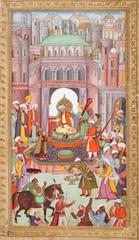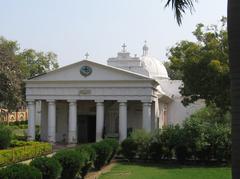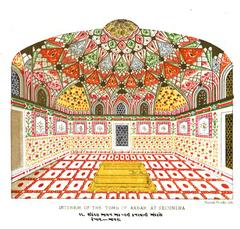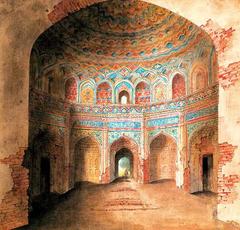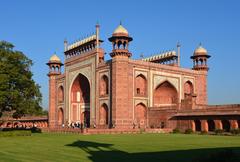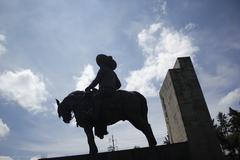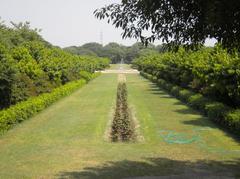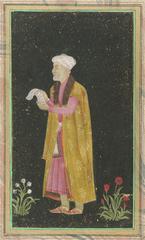Mina Mosque Visiting Hours, Tickets, and Guide to Agra Historical Sites
Date: 04/07/2025
Introduction
Nestled within the UNESCO-listed Agra Fort, the Mina Mosque—also known as Mina Masjid or the “Heavenly Mosque”—offers an intimate glimpse into the private spiritual world of Mughal Emperor Shah Jahan. Built between 1631 and 1640 CE, this elegant white marble sanctuary is set apart from the grand public mosques of its era, reflecting Shah Jahan’s personal devotion and architectural finesse.
This comprehensive guide provides a detailed overview of Mina Mosque’s history, architectural features, visiting hours, ticketing information, accessibility, and tips for exploring Agra Fort and its surroundings. Whether you’re a history aficionado or a curious traveler, this resource will help you make the most of your visit to one of Agra’s most serene and historically significant sites. For authoritative details and the latest updates, consult resources from the Archaeological Survey of India and other scholarly repositories (ASI: Agra Fort, Wikipedia: Mughal architecture, DBpedia: Mina Mosque).
Table of Contents
- Introduction
- Historical Context and Mughal Significance
- Construction and Patronage
- Architectural Features and Layout
- Spiritual and Historical Importance
- Visiting Mina Mosque: Hours, Tickets & Accessibility
- Travel Tips and Nearby Attractions
- Preservation and Current Status
- Frequently Asked Questions (FAQ)
- Summary and Final Tips
- References
Historical Context and Mughal Significance
The Mina Mosque is deeply entwined with the history of the Mughal dynasty, which transformed Agra into a center of imperial authority and architectural innovation from the 16th to 18th centuries (Wikipedia: Mughal architecture). Agra Fort itself was originally a brick fortress under Rajput rulers before Emperor Akbar rebuilt it as a formidable red sandstone citadel (1565–1573). Later, Shah Jahan adorned the fort with stunning marble structures, including the Mina Mosque (ASI: Agra Fort).
Commissioned by Shah Jahan, the Mina Mosque was designed as a secluded place of worship for the emperor, distinct from the grand congregational mosques that marked Mughal architectural achievements. Its exclusive location near the Diwan-i-Khas (Hall of Private Audience) within Agra Fort underscores its role as a personal devotional retreat (DBpedia: Mina Mosque).
Construction and Patronage
Built between 1631 and 1640 CE under the patronage of Shah Jahan, the Mina Mosque epitomizes the emperor’s penchant for refined white marble architecture, as also seen in his masterpiece, the Taj Mahal. Unlike the elaborate, publicly accessible mosques of the period, Mina Mosque was conceived for private prayer, emphasizing introspection over grandeur (DBpedia: Mina Mosque). Its quiet elegance and simplicity were intentional, offering the emperor a peaceful sanctuary during both his reign and his subsequent confinement by his son Aurangzeb.
Architectural Features and Layout
Mina Mosque stands out for its minimalist beauty. The structure, built entirely of pure white marble, projects serenity and spiritual purity.
Key Features
- Prayer Hall: A modest, rectangular hall with a flat roof supported by simple arches, designed for a small number of worshippers.
- Mihrab and Qibla Wall: The qibla wall faces Mecca and features an understated, recessed mihrab, devoid of ornamentation.
- Absence of Minarets/Domes: Unlike the Moti Masjid or Jama Masjid, the Mina Mosque lacks minarets and a grand dome, maintaining a low, flat silhouette.
- Courtyard: A small, marble-paved courtyard offers space for ablutions, enclosed by high walls for privacy.
- Entrances: Access is via a discreet, arched doorway reflecting the mosque’s private function.
The mosque’s architectural restraint distinguishes it from other Mughal-era mosques, highlighting the diversity within Islamic architecture of the period (Wikipedia: Mughal architecture).
Spiritual and Historical Importance
The Mina Mosque’s primary significance lies in its association with Shah Jahan’s private spiritual life. During his final years under house arrest, it is believed he found solace and conducted prayers here, with the nearby Musamman Burj offering views of the Taj Mahal (Indianetzone: Agra Fort). The mosque’s understated design and seclusion embody the emperor’s introspection and devotion.
Agra Fort contains multiple mosques, each serving specific purposes for the royal family: Moti Masjid for the court, Nagina Masjid for royal women, and Mina Masjid for the emperor’s personal prayers (EdTerra: Agra Fort).
Visiting Mina Mosque: Hours, Tickets & Accessibility
Visiting Hours
- Open daily in line with Agra Fort’s timings: 6:00 AM to 6:00 PM
- Direct access to the mosque is usually restricted for conservation, but it can be viewed from designated areas.
Ticket Information
- No separate ticket for Mina Mosque; entry is included in the Agra Fort ticket.
- Ticket prices (as of 2024):
- Indian citizens: ₹20
- Foreign tourists: ₹650
- Tickets are available at the fort entrance or online through official portals.
Accessibility
- The fort features uneven surfaces and steps, which may present challenges for visitors with mobility issues.
- Access to the mosque itself is limited; inquire in advance for any special permissions or assistance.
Visitor Etiquette
- Dress modestly, covering shoulders and knees.
- Remove shoes before entering the prayer hall (if access is granted).
- Maintain silence and respect the sacred atmosphere.
- Photography may be restricted inside the mosque—observe signage.
Travel Tips and Nearby Attractions
-
Best Time to Visit: October to March for pleasant weather.
-
Guided Tours: Enhance your experience and navigation within Agra Fort; guides offer valuable historical context.
-
Nearby Sites:
- Musamman Burj (offers Taj Mahal views)
- Diwan-i-Khas
- Moti Masjid
- The Taj Mahal is just a short distance away.
-
Facilities: Restrooms are available near the main entrance; food and beverage outlets are outside the fort.
-
Accessibility for Foreign Visitors: English-speaking guides are widely available; signage is in English and Hindi. Currency exchange and ATMs are accessible in Agra.
Preservation and Current Status
The Mina Mosque is under the stewardship of the Archaeological Survey of India, which oversees its conservation (ASI: Agra Fort). Its limited public access has helped preserve its original features and tranquil environment. While less prominent compared to the fort’s grander structures or the Taj Mahal, the mosque remains a poignant symbol of Shah Jahan’s personal devotion and Mughal architectural excellence.
Frequently Asked Questions (FAQ)
Q: What are Mina Mosque’s visiting hours?
A: The mosque is accessible during Agra Fort’s opening hours: 6:00 AM to 6:00 PM daily.
Q: Is there a separate ticket for Mina Mosque?
A: No, entry is included in the Agra Fort ticket.
Q: Is the mosque accessible to people with disabilities?
A: Access can be challenging due to uneven surfaces and limited entry; plan ahead and consult staff for assistance.
Q: Can I take photographs inside Mina Mosque?
A: Photography may be restricted; always check signage and consult with guides or staff.
Q: Are guided tours available?
A: Yes, guided tours of Agra Fort usually include information about Mina Mosque and can enhance your visit.
Summary and Final Tips
The Mina Mosque represents an intimate facet of Mughal history and Shah Jahan’s architectural vision. Its serene marble beauty and private ambiance offer a compelling contrast to Agra’s larger monuments. While public access may be limited, a visit—whether direct or via guided tour—adds depth to any exploration of Agra’s imperial legacy. For up-to-date information on visiting hours, tickets, and site conditions, rely on official sources such as the ASI and Agra Tourism (ASI: Agra Fort, Agra Tourism).
Including the Mina Mosque in your Agra itinerary enriches your understanding of Mughal architecture and history, offering a quiet moment for reflection amid the city’s grand heritage.
References
- ASI: Agra Fort
- Wikipedia: Mughal architecture
- DBpedia: Mina Mosque
- Indianetzone: Agra Fort
- EdTerra: Agra Fort
- Agra Tourism: Mina Masjid Agra
Alt text: Mina Mosque white marble architecture inside Agra Fort, Agra.
